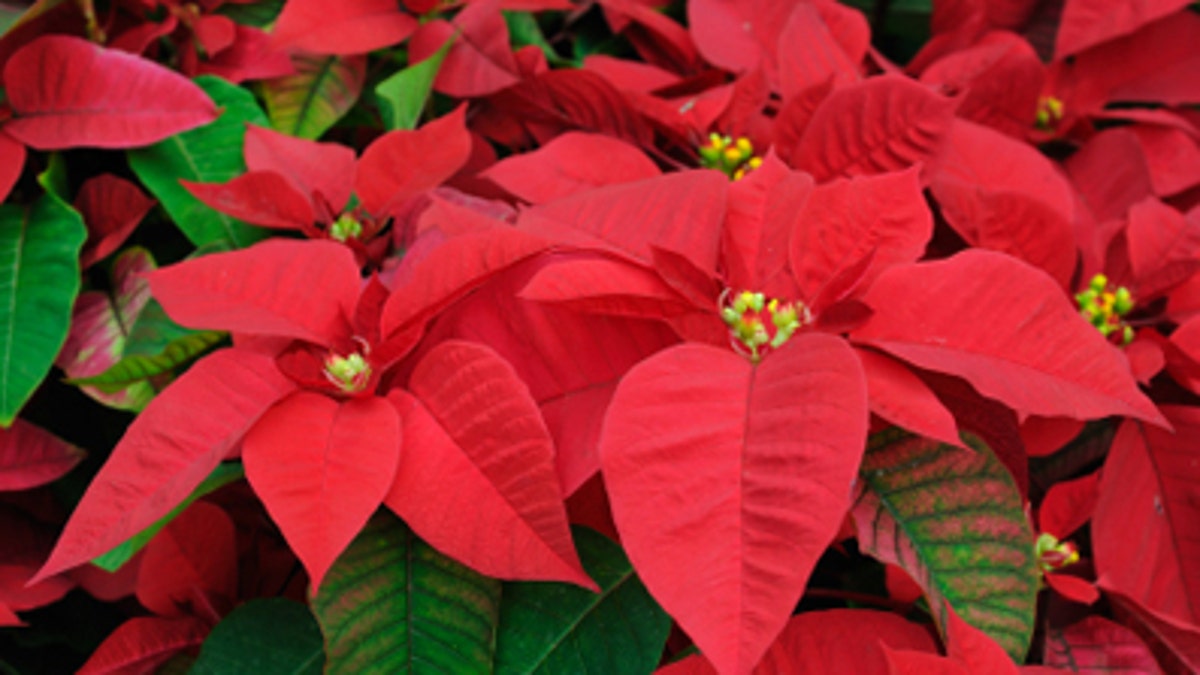
Poinsettias (iStock)
The days around Christmas can be cold, dark and blustery, so it makes sense that many Christmas customs involve filling our homes with greenery. Without those boughs of holly decking our halls, the last weeks of December might be a dreary time indeed.
But, at the same time, these botanic habits can seem to be a confusing hodgepodge of strange traditions that seem to have little connection with Christmas.
Why is there a tree in the middle of a living room? Why is a kiss required when meeting beneath the mistletoe? And just what the heck is a poinsettia?
So before you set down that holiday centerpiece and lay the final Christmas wreath, check out our guide to the perplexing array of holiday horticulture.
Poinsettias
Legend has it this crimson plant’s Christmas connection originates in 16th century Mexico. According to the story, a poor Mexican girl grabbed a clutch of weeds from the side of the road, unable to afford anything more costly to offer as a gift. Bundling the stems into a bouquet, she brought the poinsettias to the church’s altar, where the green leaves burst into a crimson blossom, an allusion to Christ’s suffering on the cross.
Now a ubiquitous Christmas table setting, the poinsettia serves as a reminder that even the most meager gifts are capable of embodying the spirit of the holidays.
The red portion of this small tree are often confused for the plant’s flowers. In fact, these are the plant’s upper leaves, which turn a vibrant color when exposed to long periods of darkness during the short winter days.
However, once the bloom goes out of a poinsettia, it is almost impossible to get this finicky plant to transform a second time. So if you’re looking for another bright red bouquet on your holiday table, you’re going to have to purchase a new one next year.
Holly
Like a few of our current-day Christmas traditions, the holly wreath has its roots in ancient pagan celebrations. The custom of decorating a house with holly is thought to have started with the druids of ancient Britain, who prized it for the lustrous green hue it maintained through the coldest months. Holly decorations were later adopted by the Romans, who featured it during the festival of Saturnalia, an ancient feast that coincided with Christmas.
As Roman traditions gave way to Christian ones across Europe, the practice of hanging holly took on new meaning. The plant’s spiny leaves reminded Christians of Christ’s crown of thorns and its berries like droplets of blood.
Christmas Trees
The Christmas tree, that bright spot of greenery at the center of the home during the holidays, is a tradition with more than 1000 years of history behind it. It’s said that St. Boniface chopped down a tree to disprove the presence of pagan tree gods, giving a holiday tradition its start.
The earliest references of an indoor tree to celebrate Christmas date back to 15th century Eastern Europe. The practice became more common in Germany in the 1600s and spread throughout Europe and North America from there. But it wasn’t until the Victorian era that a tree in the home became the norm. By the early 19th century, Christmas tree traditions were very similar to what we know today — decorations, a string of lights (candles in those days) and a bounty of presents beneath its branches.
Mistletoe
The most romantic of Christmas customs, mistletoe has been connected with kissing for at least 200 years. According to tradition, when two find themselves below the mistletoe, they are to share a kiss and then pluck a berry from the plant. Once all the berries have been plucked, the plant’s romantic obligation ceases. The origin of this custom is murky, but seems to be related to an ancient European connection between the plant and fertility.
Though a nice benefit, conjuring kisses was not the primary purpose of hanging the plant. Mistletoe, which is actually a parasitic plant that grows in the branches of trees or shrubs, is thought to confer luck and safety on any house it hangs in, so long as it never touches the ground from the moment it’s cut. But whether is keeps your home safe, or sparks a brief moment of romance, a lock of mistletoe hanging in the home is a constant reminder that even when chilly winds are blowing outside, a holiday home can be a place of warmth, love – and greenery.